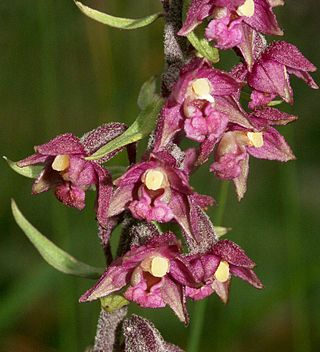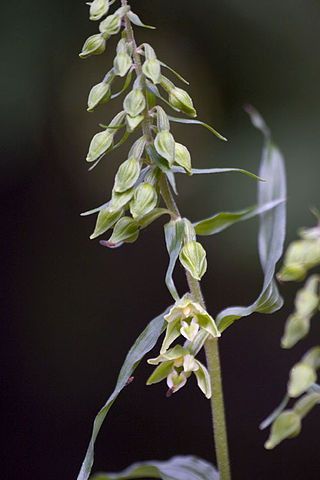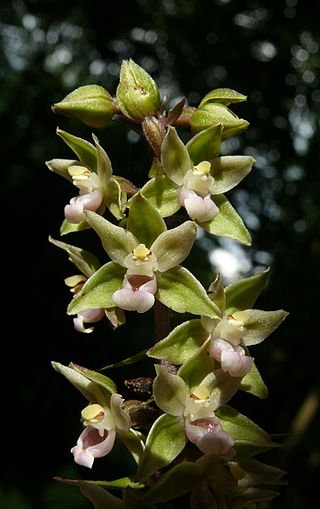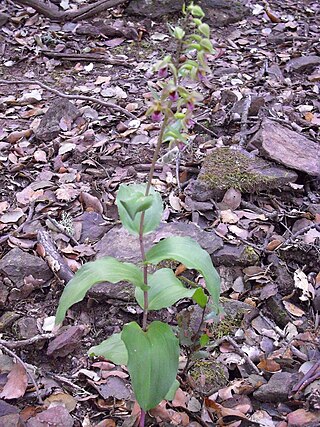
Epipactis, or helleborine, is a genus of terrestrial orchids consisting of approximately 70 species. This genus is abbreviated as Epcts in horticultural trade.
False helleborine is a name is used in different parts of the world to describe several different plants of either the Orchid family or the Lily family.

Cephalanthera rubra, known as red helleborine, is an orchid found in Europe, North Africa and southwest Asia. Although reasonably common in parts of its range, this Cephalanthera has always been one of the rarest orchids in Britain.

Windsor Hill is a 61.8-hectare (153-acre) biological Site of Special Scientific Interest in Princes Risborough in Buckinghamshire. It lies within the Chilterns Area of Outstanding Natural Beauty, and it is featured in the Nature Conservation Review. A small part is managed by the Berkshire, Buckinghamshire and Oxfordshire Wildlife Trust, and access to this area requires a permit.

Cephalanthera longifolia, the narrow-leaved helleborine, sword-leaved helleborine or long-leaved helleborine, is a rhizomatous herbaceous perennial plant in the family Orchidaceae. It is native to light woodland, and widespread across Europe, Asia and North Africa from Ireland and Morocco to China. This includes the United Kingdom, Iran, Russia, Kazakhstan, Turkey, Algeria, India, Pakistan, Germany, Italy, France, Spain, Portugal and many other countries.

Epipactis atrorubens, the dark-red helleborine or royal helleborine, is an herbaceous plant in the orchid family, Orchidaceae.

Postlebury Wood is an 87 hectare biological Site of Special Scientific Interest south of Trudoxhill in Somerset, notified in 1987.

Epipactis helleborine, the broad-leaved helleborine, is a terrestrial species of orchid with a broad distribution. It is a long lived herb which varies morphologically with ability to self-pollinate.

Epipactis palustris, the marsh helleborine, is a species of orchid native to Europe and Asia.

Epipactis phyllanthes, the green-flowered helleborine, is an orchid found in the western Palearctic realm.

Epipactis purpurata, the violet helleborine, is an orchid widely distributed in Europe.
Epipactis helleborine var. youngiana, known as Young's helleborine, is a variety of orchid that is endemic to Great Britain. It has also been treated as a separate species, Epipactis youngiana.

Epipactis gigantea is a species of orchid known as the stream orchid, giant helleborine, and chatterbox. This wildflower is native to western North America from British Columbia to central Mexico. This is one of the most abundant orchids of the Pacific coast of North America.

Cephalanthera damasonium, the white helleborine, is a species of orchid. It is widespread across much of Europe, the Middle East and Asia. Cephalanthera damasonium is the type species of the genus Cephalanthera.

Epipactis microphylla, the small-leaved helleborine, is a species of orchid. It is native to much of Europe and to Southwest Asia as far east as Iran though noticeably absent from the British Isles and from Scandinavia. It has also been found in North Africa, in the Babor mountains in Little Kabylia, Algeria.

Epipactis tremolsii is a species of terrestrial orchid in the genus Epipactis. It is confined to the western Mediterranean region where it grows in open mixed oak, cork oak and pine woodland. In Portugal in the Algarve region, it flowers rather earlier than Epipactis helleborine and can be found from April onwards.

Epipactis dunensis, commonly known as dune helleborine, is a species of plant in the orchid family Orchidaceae and is endemic to Great Britain and Ireland. It typically grows to a height of 20–50 cm (7.9–19.7 in) and the upper half of the flowering stalk is hairy. The plant has a long, fleshy rootstock and three to ten yellowish green, oval to lance-shaped leaves arranged in opposite rows along the flowering stem with up to 35 flowers. The three sepals are greenish, the two petals paler, the lower part of the labellum is boat-shaped and dark, chocolate brown with a transparent, whitish rim and the epichile is heart-shaped with a pointed tip. Flowering occurs from late June to mid-August, the flowers are mainly self-pollinated, and the fruit is a capsule, from which light, microscopic seeds are spread by the wind.

Lindisfarne National Nature Reserve is a 3,541-hectare (8,750-acre) UK national nature reserve. It was founded to help safeguard the internationally important wintering bird populations, and six internationally important species of wildfowl and wading birds winter here. For the pale-bellied brent geese from Svalbard, this is their only regular wintering place in all of the United Kingdom. Pinkfooted and greylag geese, wigeons, grey plovers and bar-tailed godwits are the other visitors.
Beltingham River Shingle is the name given to a Site of Special Scientific Interest (SSSI) in Northumberland in the north-east of England, notable for an unusual community of flora tolerant to the high levels of naturally occurring heavy metals in the sediment of a section of the River South Tyne.
















